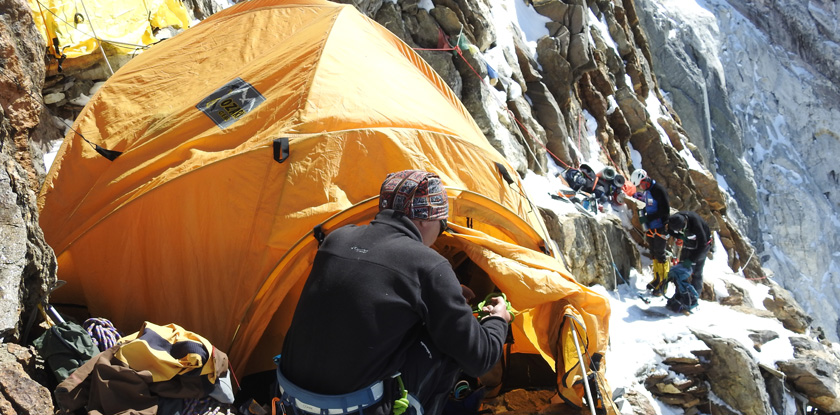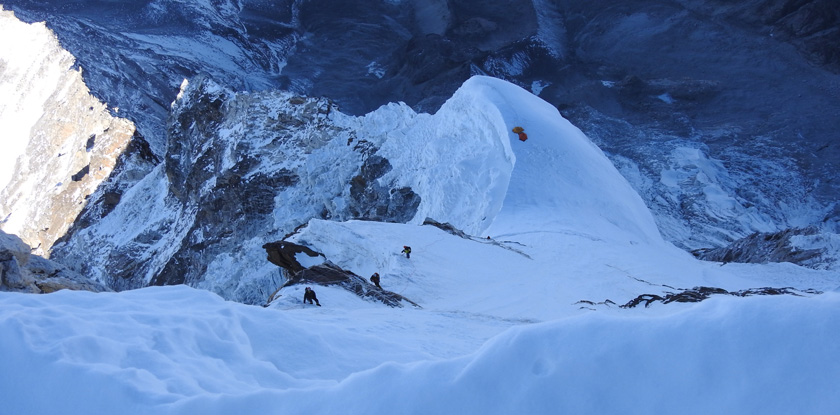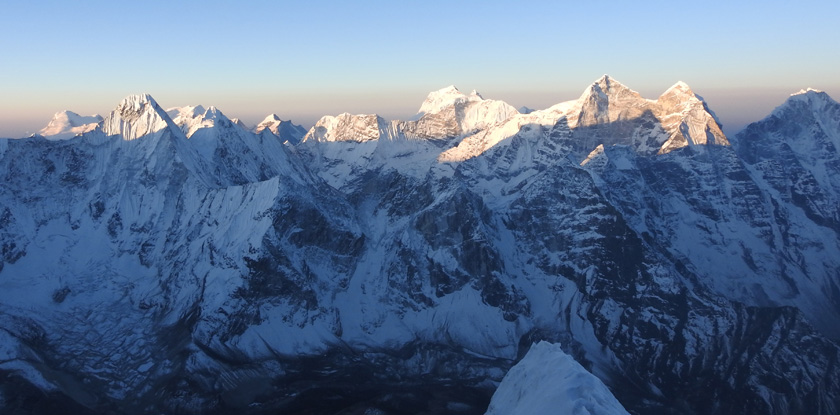
Ama Dablam Climbing
A must do climb for all the mountaineers from the world, Ama Dablam is considered as a Matterhorn of Nepal. The peak stands at the height of 6,812 meter above sea level and considered as the most photogenic mountain of the world. The breathtaking view of Ama Dablam from Everest base Camp trek pulled many of our clients to climb this peak and they make their second trip in Everest area reaching the top of this peak. The success rate to reach the top of this peak is quite high and the climbing period is relatively short which contributed for attracting more alpinist every year to reach the top of Ama Dablam. The great views of Himalayan peaks from the top as well as the route and low cost compared to many of the similar height peaks on other part of Himalayas lure many expedition lovers to choose this peak as the next climbing destination. The prompt rescue facilities is available in Everest area in case of emergencies also contributing votes for novice climbers to choose peaks from Everest area in the bucket list for their climbing destination. Climbing Ama Dablam is a mixed idea which needs some technical part and better than trekking peaks. Pre experience is not necessarily a requisite to climb this peak and successful climb to this peak open doors to climb many of the higher peaks in the Everest area. A permit is necessary for climbing any peaks in Nepal and Ama Dablam is not the exclusion so the permit is issued for a group as low as two members but if you are alone you still get opportunity to climb joining other people and give a try with flexible plans.

Trip itinerary for climbing Ama Dablam
Day 1: International arrival and free afternoon to recover from the jetlag.
Day 2: Expedition gear inspection, permit processing, packing, necessary gear shopping, renting equipment.
Day 3: Morning flight to Lukla and walk up to Phakding.
Day 4: Trek from Phakding to Namche, the biggest village of the area and door to the Everest region.
Day 5: Acclimatization day at Namche discovering the nearby areas, normally spent by climbing higher and come down to Namche for overnight sleep.
Day 6: Trek from Namche to Tyangboche, scenic view of Everest at the beginning then descends and finally ascends to reach the village of Tyangboche, observe the monastery, get blessing from the monks for successful trip to the top of Ama Dablam.
Day 7: Trek from Tyangboche to Ama Dablam Base Camp, discover the area, gaze the view of the mountain which is climbed by you in few days.
Day 8-10: Rest and hike around the area, check the weather, acclimatize and prepare for the hard hit.
Day 11: Ama Dablam base camp to Camp I. 5700 m. normally takes 5-6 hours, at the beginning the trail look like normal trekking route and last part is very rocky terrain. The rocky part walk is about 30-45 minutes. The camp is located at the safe rocky terrain, completely safe from avalanches. There is a good view of Pangboche village, Ama Dablam base camp, Tawoche, Kangtenga and Thamserku peaks, Migma-La pass one night sleep there at camp I and back to base camp.
Day 12-13: Rest at Base camp so the body will be perfectly acclimatized and prepared for the high altitude.
Day 14: Move from base camp to Camp I again and overnight at camp I.
Day 15: Climb from camp I to camp II, it takes about 4-5 hours, the terrain is rocky full of scree, and some talus deposits is also visible, special preparation with jumaring or go with ascender. The camp II is located in elevated area like an small island. The view is more or less similar of camp I.
Day 16: Summit and back to camp II. The Summit day, the highlight of the whole trip, busy day and hardest day, exhausting day full of mind blowing experience. Normally starts at about 11 pm or mid night and reach the top around 8-9 am. The walk in the night time protect from danger of the avalanches as the occurrence of the avalanches is high when there is a heat from sun and ice melts. Mostly weather is clear in the morning so one can get mesmerizing view in the morning from the top. As sun goes high there will be wind of high intensity making uncomfortable to climb.

Day 17: Camp II to Ama Dablam base camp. 5-6 hours of easy descends and hot regular meals as well as celebration of the trip.
Day 18: Rest and preparation to head back, dry your gears, tents all in base camp and prepare to walk back to Lukla.
Day 19: Trek back to Namche from Ama Dablam base camp.
Day 20: Trek back to Lukla,
Day 21: early morning flight to Kathmandu and rest day.
Day 22: free day in Kathmandu to do optional sightseeing, massage or shopping.
Day23: Departure from Kathmandu
Personal equipment to bring for this trip
A nice sleeping bag, harness, Jumar or ascender, descender, carabinars, climbing boot, crampons, prusik rope, headlight etc.
What company provides:
Tents, lodging and fooding except Kathmandu, Sherpa and other crew, group equipment like guide rope etc.
What to eat during climbing days?
Besides packed light weight expedition or high altitude food we provide ample amount of tea coffee, porridge, spaghetti, soup chocolate bar and hot chocolates. Most of the necessary foods can be bought in Kathmandu too.
How is the drinking water?
The main source of water is melting the ice which is used for drinking, cooking and cleaning.
You can combine this trip with Everest Base camp trek or you can also combine with Island Peak Climbing



